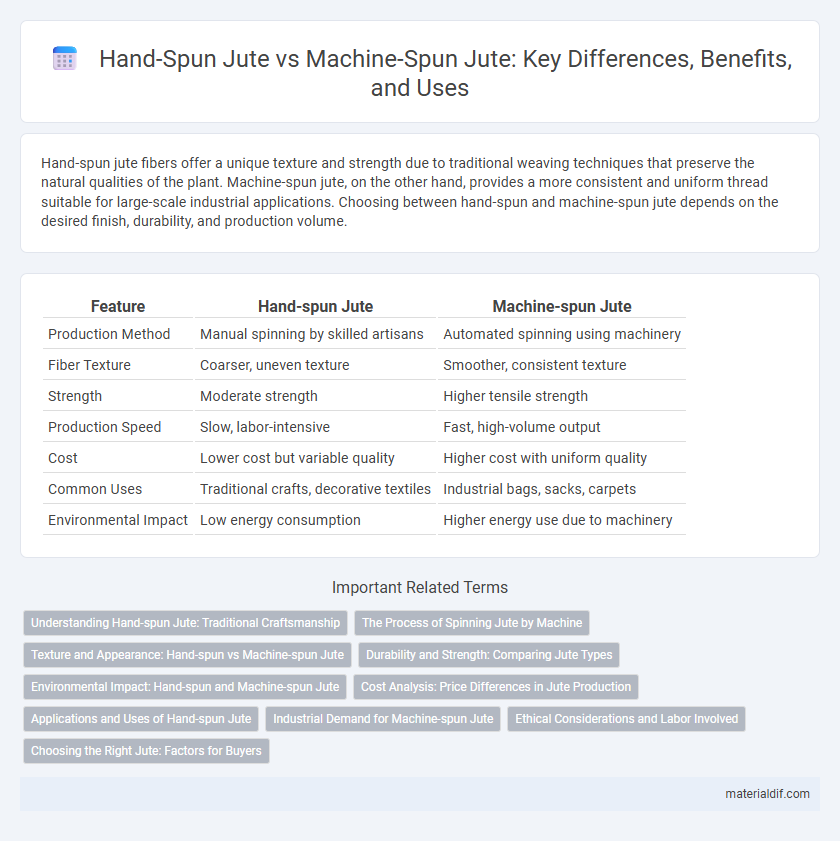Hand-spun jute fibers offer a unique texture and strength due to traditional weaving techniques that preserve the natural qualities of the plant. Machine-spun jute, on the other hand, provides a more consistent and uniform thread suitable for large-scale industrial applications. Choosing between hand-spun and machine-spun jute depends on the desired finish, durability, and production volume.
Table of Comparison
| Feature | Hand-spun Jute | Machine-spun Jute |
|---|---|---|
| Production Method | Manual spinning by skilled artisans | Automated spinning using machinery |
| Fiber Texture | Coarser, uneven texture | Smoother, consistent texture |
| Strength | Moderate strength | Higher tensile strength |
| Production Speed | Slow, labor-intensive | Fast, high-volume output |
| Cost | Lower cost but variable quality | Higher cost with uniform quality |
| Common Uses | Traditional crafts, decorative textiles | Industrial bags, sacks, carpets |
| Environmental Impact | Low energy consumption | Higher energy use due to machinery |
Understanding Hand-spun Jute: Traditional Craftsmanship
Hand-spun jute exemplifies traditional craftsmanship, where artisans skillfully twist natural jute fibers by hand to create stronger, more textured yarn. This manual process preserves the fibers' natural strength and flexibility, resulting in unique, high-quality jute products with distinct rustic appeal. Hand-spun jute often supports sustainable and ethical practices by empowering local communities and maintaining cultural heritage.
The Process of Spinning Jute by Machine
Machine-spun jute involves automated machinery that efficiently converts raw jute fibers into consistent yarn through processes like carding, drawing, and spinning, significantly increasing production speed compared to hand-spinning. Advanced spinning machines ensure uniform twist and strength in the jute thread, enhancing its durability for industrial applications such as sacks, ropes, and carpets. The mechanical process reduces labor intensity while maintaining the natural coarse texture characteristic of jute fiber.
Texture and Appearance: Hand-spun vs Machine-spun Jute
Hand-spun jute fibers exhibit a coarse, uneven texture with natural variations, contributing to a rustic and authentic appearance favored in artisanal products. Machine-spun jute fibers are uniform, smoother, and tightly twisted, resulting in a more consistent texture and polished appearance suitable for mass-produced goods. The texture difference directly influences the aesthetic appeal, with hand-spun jute valued for traditional crafts and machine-spun jute preferred for industrial applications.
Durability and Strength: Comparing Jute Types
Hand-spun jute fibers exhibit greater durability and tensile strength due to the careful, manual extraction process that preserves fiber integrity. Machine-spun jute, while produced faster and in larger quantities, often shows weaker fiber cohesion and reduced longevity in comparison. The natural alignment and fewer breaks in hand-spun jute make it more resilient for heavy-duty applications such as rope and upholstery.
Environmental Impact: Hand-spun and Machine-spun Jute
Hand-spun jute has a lower environmental impact due to minimal energy consumption and reduced carbon emissions compared to machine-spun jute, which relies heavily on electricity and fossil fuels. The manual spinning process preserves the fiber's natural qualities, promoting biodegradability and reducing chemical use. Machine-spun jute increases production speed but often involves synthetic lubricants and energy-intensive machinery, contributing to greater ecological footprints.
Cost Analysis: Price Differences in Jute Production
Hand-spun jute typically incurs higher labor costs due to the intensive manual process, resulting in a premium price compared to machine-spun jute. Machine-spun jute benefits from economies of scale and faster production rates, driving down the overall cost per kilogram. Price differences also reflect the variance in fiber quality and uniformity, with hand-spun jute often valued for artisanal characteristics despite its higher cost.
Applications and Uses of Hand-spun Jute
Hand-spun jute is prized in artisanal crafts and eco-friendly products due to its natural texture and durability, making it ideal for traditional rugs, bags, and home decor items. Unlike machine-spun jute, hand-spun fibers maintain a unique, coarse quality that enhances the aesthetic and tactile appeal of handmade goods. This type of jute is commonly used in niche markets focused on sustainable fashion, organic upholstery, and heritage textiles.
Industrial Demand for Machine-spun Jute
Machine-spun jute dominates the industrial market due to its consistent fiber length, strength, and uniform texture, which ensure high-quality output in large-scale manufacturing. Industrial demand for machine-spun jute has surged, driven by its compatibility with automated machinery and applications in packaging, textiles, and composites. The scalability and efficiency of machine-spun jute production meet the growing needs of eco-friendly industries seeking sustainable alternatives to synthetic materials.
Ethical Considerations and Labor Involved
Hand-spun jute supports traditional artisans by preserving cultural heritage and providing fair wages, promoting ethical labor practices in rural communities. Machine-spun jute, while more efficient in production, often relies on industrial labor conditions that may lack transparency and fair treatment. Prioritizing hand-spun jute fosters sustainable employment and empowers small-scale workers, aligning with ethical sourcing standards.
Choosing the Right Jute: Factors for Buyers
Hand-spun jute offers unique texture and traditional craftsmanship, appealing to buyers seeking artisanal quality and sustainability. Machine-spun jute provides consistent fiber strength and uniformity, ideal for large-scale industrial applications requiring durability and efficiency. Buyers must consider factors such as end-use requirements, budget constraints, and environmental impact when selecting between hand-spun and machine-spun jute.
Hand-spun Jute vs Machine-spun Jute Infographic

 materialdif.com
materialdif.com